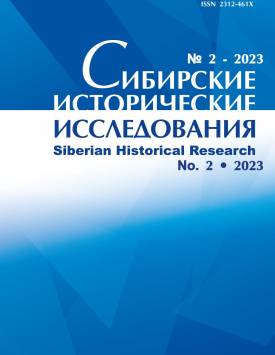Innovations and technological transfer in ancient metallurgy
Metallurgical production is a complex of interrelated technological operations, so innovations in it are also complex. In the Bronze Age, they arose only in the case of solving some socio-economic problems. The main impetus for these innovations was the growing demand for metal. However, most of them were not purposeful acts of invention at all. More often they were formed by random technological mutations, and if these mutations made it possible to solve some urgent problems, the new technological scheme was consolidated as an innovation. The transfer of technologies to other areas depended on their nature. In the period of dominance of arsenic alloys, alloying was closely related to the used ore, its smelting technologies, and subsequent foundry and forging operations. As a result, for the transfer of this entire complex, the coming of people, the bearers of this knowledge, was needed. With the invention of tin alloys, metalworking processes were separated from ore smelting. In these new conditions, even the coming of people with this new technology did not lead to its implementation. A prerequisite in this case was inclusion in the copper and tin trading system. However, despite the clear dependence of the development of technologies on social processes, their general direction in the development of ancient metallurgy was caused by universal physical and chemical laws, which provided a relatively similar picture of these innovations in different regions of Eurasia. The second reason for this similarity was that most of the major innovations came from the Near East.
Keywords
ancient metallurgy,
technology,
innovations,
technological transfer,
ore smelting,
alloysAuthors
| Grigoriev Stanislav Arkadievich | Institute of History and Archaeology, Ural Branch of the Russian Academy of Sciences | stgrig@mail.ru |
Всего: 1
References
Анкушев М.Н., Артемьев Д.А., Блинов И.А. Металлургия бронзового века на поселении Талдысай: руды, шлаки, легирование // Талдысай - поселение древних металлургов позднебронзового века в Улытауской степи / отв. ред. Ж. Курманкулов. Алматы: ИА КН МОН РК, 2020. С. 72-93.
Григорьев С.А. Миграционные процессы на Южном Урале при переходе к позднему бронзовому веку // Уральский исторический вестник. 2020. № 4. С. 24-31.
Григорьев С.А. Развитие металлургии меди и медных сплавов в Китае во II тыс. до н. э. // Вестник археологии, антропологии и этнографии. 2022. № 2 (57). С. 31-43.
Рындина Н.В., Дегтярева А.Д. Энеолит и бронзовый век. М.: МГУ, 2002.
Черных Е.Н. Каргалы. Т. V: Каргалы: феномен и парадоксы развития. Каргалы в системе металлургических провинций. М.: Наука, 2007.
Черных Е.Н., Кузьминых С.В. Древняя металлургия Северной Евразии. М., 1989.
Barjamovic G.A. Historical Geography of Anatolia in the Old Assyrian Colony Period. Copenhagen: Museum Tusculanum Press, 2011.
Bartelheim M. Die Rolle der Metallurgie in vorgeschichtlichen Gesellschaften. Soziookonomische und kulturhistorische Aspekte der Ressourcennutzung. Ein Vergleich zwischen Andalusien, Zypern und Nordalpenraum. Rahden/Westf.: Marie Leidorf Verlag, 2007.
Chang K.C. Shang Civilization. New Heaven, London: Yale University Press, 1980.
Charles J.A. The Coming of Copper and Copper-Base Alloys and Iron: A Metallurgical Sequence // The Coming of the Age of Iron. New Haven, London: Yale University Press, 1980.
Fan X., Harbottle G., Gao Q., Zhou W., Gong Q., Wang H., Yu X., Wang Ch. Brass before bronze? Early copper-alloy metallurgy in China // Journal of Analytical Atomic Spectrometry. 2012. № 27. P. 821-826.
Grigoriev S. Social processes in Ancient Eurasia and development of types of alloys in metallurgical production // Archaeoastronomy and Ancient Technologies. 2017. № 5(2). P. 1744.
Grigoriev S. Social processes in ancient Europe and changes in the use of ore and alloys in metallurgical production // Archaeoastronomy and Ancient Technologies. 2018. № 7(2). P. 1-30.
Muhly J.D. Copper and tin. The distribution of mineral resources and the nature of the metals trade in the Bronze Age. Hamden: Archon Books, 1973.
O'Brien W. Ross Island. Mining, Metal and Society in Early Ireland. Galway: National University of Ireland, 2004.
Sperber L. Zur Bedeutung des nordlichen Alpenraumes fur die spatbronzezeitliche Kupferver-sorgung in Mitteleuropa mit besonderer Berucksichtigung Nordtirols // Alpenkupfer -Rame delle Alpi. Der Anschnitt. Beiheft 17. Bochum: Deutsche Bergbaumuseum 122, 2004. S. 303-345.
Radivojevic M., Rehren T., Kuzmanovic-Cvetkovic J., Jovanovic M. Why are there tin bronzes in the 5th mill. BC Balkans? // Archaeotechnology: Studying Technology from Prehistory to the Middle Ages. Prosveta: Belgrade: Prosveta, 2014. P. 235-256.
Roberts B.W., Thornton C.P., Pigott V.C. Development of metallurgy in Eurasia // Antiquity. 2009. № 83. P. 1012-1022.
Vandkilde H. Bronzization: The Bronze Age as Pre-Modern Globalization // Praehistorische Zeitschrift. 2016. № 91(1). P. 103-123.
Wagner D.B. Iron and steel in ancient China. Leiden: Brill, 1993.
Weisgeber G. Schmelzanlagen fruher Kupfergewinnung - ein Blick uber die Alpen // Alpen-kupfer - Rame delle Alpi. Der Anschnitt. Beiheft 17. Bochum: Deutsche Bergbaumuseum 122, 2004. S. 15-36.
Wiener M.H. Helladic Greece from the Middle Bronze Age to c. 1350 BCE // From Past to Present. Studies in Memory of Manfred O. Korfmann. Bonn: Rudolf Habelt Verlag, 2020. P. 279-332.

